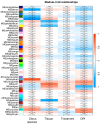Exploring the Genetic Networks of HLB Tolerance in Citrus: Insights Across Species and Tissues
- PMID: 40573779
- PMCID: PMC12197043
- DOI: 10.3390/plants14121792
Exploring the Genetic Networks of HLB Tolerance in Citrus: Insights Across Species and Tissues
Abstract
Huanglongbing (HLB), caused mainly by Candidatus Liberibacter asiaticus (CLas), is a devastating disease threatening citrus production worldwide, leading to leaf mottling, fruit deformation, and significant yield losses. This study generated a comprehensive co-expression network analysis using RNA-seq data from 17 public datasets. Weighted gene co-expression network analysis (WGCNA) was applied to identify gene modules associated with citrus species, tissue types, and days post-infection (DPIs). These modules revealed significant enrichment in biological pathways related to stress responses, metabolic reprograming, ribosomal protein synthesis, chloroplast and plastid function, cellular architecture, and intracellular transport. The results offer a molecular framework for understanding HLB pathogenesis and host response. By elucidating module-specific functions and their correlation with species- and tissue-specific responses, this study provides a robust foundation for identifying key genetic targets. These insights facilitate breeding programs focused on developing HLB-tolerant citrus cultivars, contributing to the long-term sustainability and resilience of global citrus production.
Keywords: HLB; RNA-seq analysis; citrus varieties tolerance; gene co-expression network.
Conflict of interest statement
The authors declare no conflicts of interest.
Figures








Similar articles
-
Exploring the biochemical and molecular mechanisms that contribute to Huanglongbing (HLB) tolerance in Citrus australis hybrids.BMC Genomics. 2025 Aug 19;26(1):761. doi: 10.1186/s12864-025-11942-x. BMC Genomics. 2025. PMID: 40830759 Free PMC article.
-
Transcriptomic Reprogramming and Key Molecular Pathways Underlying Huanglongbing Tolerance and Susceptibility in Six Citrus Cultivars.Int J Mol Sci. 2025 Jul 30;26(15):7359. doi: 10.3390/ijms26157359. Int J Mol Sci. 2025. PMID: 40806488 Free PMC article.
-
Genome-wide identification and comparative expression profiling of the WRKY transcription factor family in two Citrus species with different Candidatus Liberibacter asiaticus susceptibility.BMC Plant Biol. 2023 Mar 24;23(1):159. doi: 10.1186/s12870-023-04156-4. BMC Plant Biol. 2023. PMID: 36959536 Free PMC article.
-
Insights into the Huanglongbing pandemic focusing on transmission biology, virulence factors and multifaceted management strategies.Pest Manag Sci. 2025 Jul 23. doi: 10.1002/ps.70073. Online ahead of print. Pest Manag Sci. 2025. PMID: 40698841 Review.
-
Systemic pharmacological treatments for chronic plaque psoriasis: a network meta-analysis.Cochrane Database Syst Rev. 2021 Apr 19;4(4):CD011535. doi: 10.1002/14651858.CD011535.pub4. Cochrane Database Syst Rev. 2021. Update in: Cochrane Database Syst Rev. 2022 May 23;5:CD011535. doi: 10.1002/14651858.CD011535.pub5. PMID: 33871055 Free PMC article. Updated.
References
-
- Bové J.M. Huanglongbing: A Destructive, Newly-Emerging, Century-Old Disease of Citrus. J. Plant Pathol. 2006;88:7–37.
-
- Reinking O.A. Diseases of Economic Plants in Southern China. Philipp. Agric. 1919;8:109–134.
-
- Husain M.A., Nath D. Memoirs of Department of Agriculture in India (Entomological Series) Volume 10. Thacker, Spink, and Company; Calcutta, India: 1927. The Citrus Psylla (Diaphorina Citri, Kuw.) Psyllidae: Homoptera; pp. 5–27.
LinkOut - more resources
Full Text Sources

